2008 FIAT SEDICI warning light
[x] Cancel search: warning lightPage 164 of 266
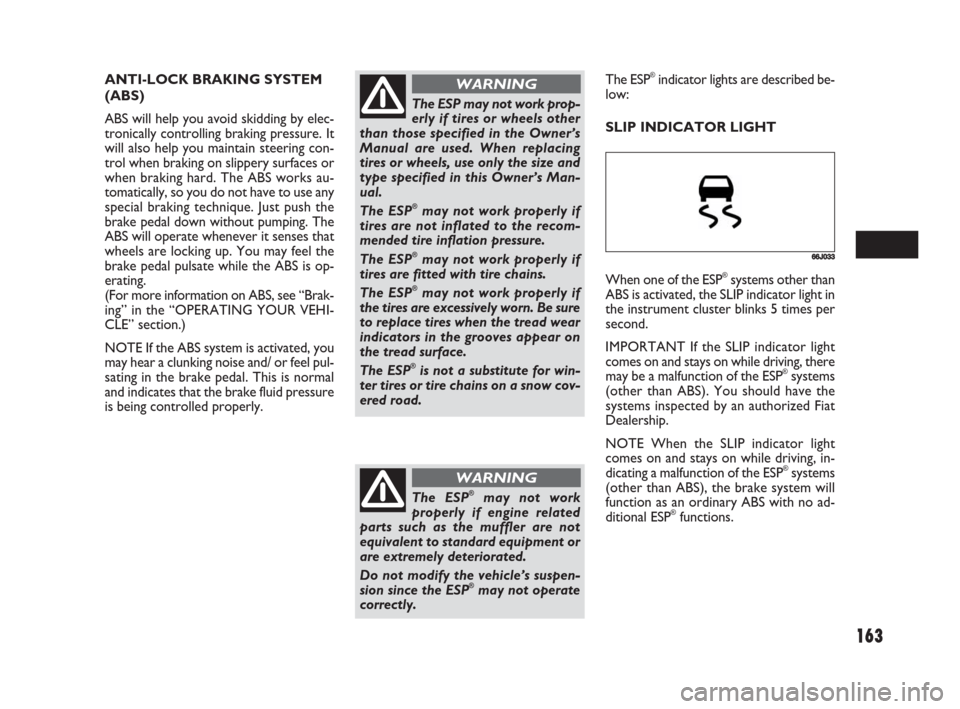
163
The ESP may not work prop-
erly if tires or wheels other
than those specified in the Owner’s
Manual are used. When replacing
tires or wheels, use only the size and
type specified in this Owner’s Man-
ual.
The ESP
®may not work properly if
tires are not inflated to the recom-
mended tire inflation pressure.
The ESP
®may not work properly if
tires are fitted with tire chains.
The ESP
®may not work properly if
the tires are excessively worn. Be sure
to replace tires when the tread wear
indicators in the grooves appear on
the tread surface.
The ESP
®is not a substitute for win-
ter tires or tire chains on a snow cov-
ered road.
WARNING
The ESP®may not work
properly if engine related
parts such as the muffler are not
equivalent to standard equipment or
are extremely deteriorated.
Do not modify the vehicle’s suspen-
sion since the ESP
®may not operate
correctly.
WARNING
ANTI-LOCK BRAKING SYSTEM
(ABS)
ABS will help you avoid skidding by elec-
tronically controlling braking pressure. It
will also help you maintain steering con-
trol when braking on slippery surfaces or
when braking hard. The ABS works au-
tomatically, so you do not have to use any
special braking technique. Just push the
brake pedal down without pumping. The
ABS will operate whenever it senses that
wheels are locking up. You may feel the
brake pedal pulsate while the ABS is op-
erating.
(For more information on ABS, see “Brak-
ing” in the “OPERATING YOUR VEHI-
CLE” section.)
NOTE If the ABS system is activated, you
may hear a clunking noise and/ or feel pul-
sating in the brake pedal. This is normal
and indicates that the brake fluid pressure
is being controlled properly.The ESP®indicator lights are described be-
low:
SLIP INDICATOR LIGHT
66J033
When one of the ESP®systems other than
ABS is activated, the SLIP indicator light in
the instrument cluster blinks 5 times per
second.
IMPORTANT If the SLIP indicator light
comes on and stays on while driving, there
may be a malfunction of the ESP
®systems
(other than ABS). You should have the
systems inspected by an authorized Fiat
Dealership.
NOTE When the SLIP indicator light
comes on and stays on while driving, in-
dicating a malfunction of the ESP
®systems
(other than ABS), the brake system will
function as an ordinary ABS with no ad-
ditional ESP
®functions.
149-166 Fiat16 New GB 3-09-2008 8:15 Pagina 163
Page 165 of 266
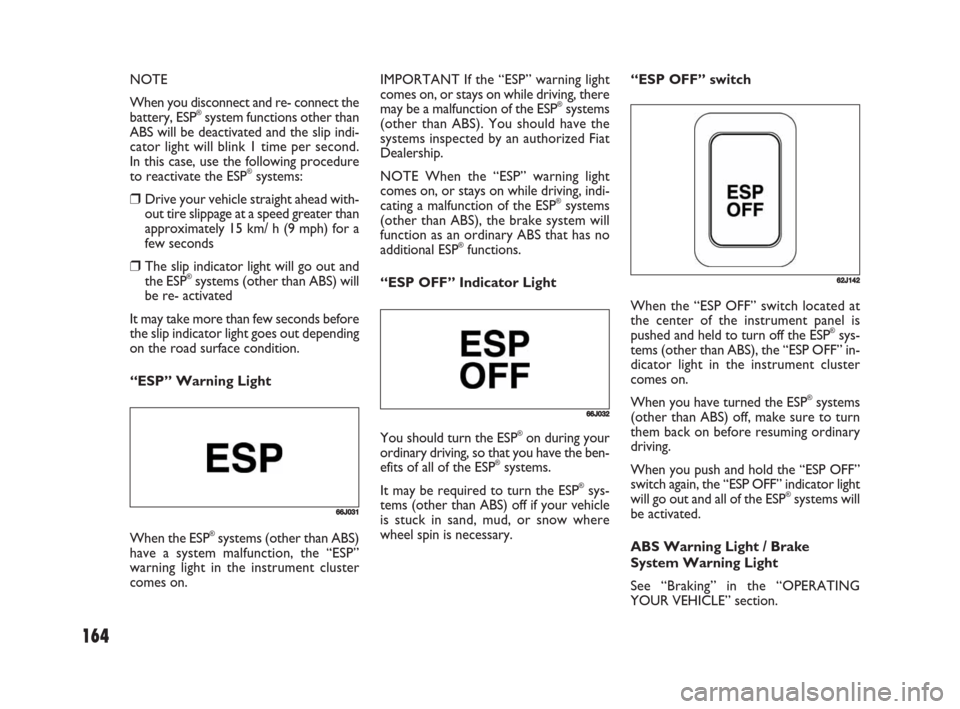
164
NOTE
When you disconnect and re- connect the
battery, ESP
®system functions other than
ABS will be deactivated and the slip indi-
cator light will blink 1 time per second.
In this case, use the following procedure
to reactivate the ESP
®systems:
❒Drive your vehicle straight ahead with-
out tire slippage at a speed greater than
approximately 15 km/ h (9 mph) for a
few seconds
❒The slip indicator light will go out and
the ESP®systems (other than ABS) will
be re- activated
It may take more than few seconds before
the slip indicator light goes out depending
on the road surface condition.
“ESP” Warning LightIMPORTANT If the “ESP” warning light
comes on, or stays on while driving, there
may be a malfunction of the ESP
®systems
(other than ABS). You should have the
systems inspected by an authorized Fiat
Dealership.
NOTE When the “ESP” warning light
comes on, or stays on while driving, indi-
cating a malfunction of the ESP
®systems
(other than ABS), the brake system will
function as an ordinary ABS that has no
additional ESP
®functions.
“ESP OFF” Indicator Light“ESP OFF” switch
When the “ESP OFF” switch located at
the center of the instrument panel is
pushed and held to turn off the ESP
®sys-
tems (other than ABS), the “ESP OFF” in-
dicator light in the instrument cluster
comes on.
When you have turned the ESP
®systems
(other than ABS) off, make sure to turn
them back on before resuming ordinary
driving.
When you push and hold the “ESP OFF”
switch again, the “ESP OFF” indicator light
will go out and all of the ESP
®systems will
be activated.
ABS Warning Light / Brake
System Warning Light
See “Braking” in the “OPERATING
YOUR VEHICLE” section.66J031
When the ESP®systems (other than ABS)
have a system malfunction, the “ESP”
warning light in the instrument cluster
comes on.
66J032
You should turn the ESP®on during your
ordinary driving, so that you have the ben-
efits of all of the ESP
®systems.
It may be required to turn the ESP
®sys-
tems (other than ABS) off if your vehicle
is stuck in sand, mud, or snow where
wheel spin is necessary.
62J142
149-166 Fiat16 New GB 3-09-2008 8:15 Pagina 164
Page 167 of 266
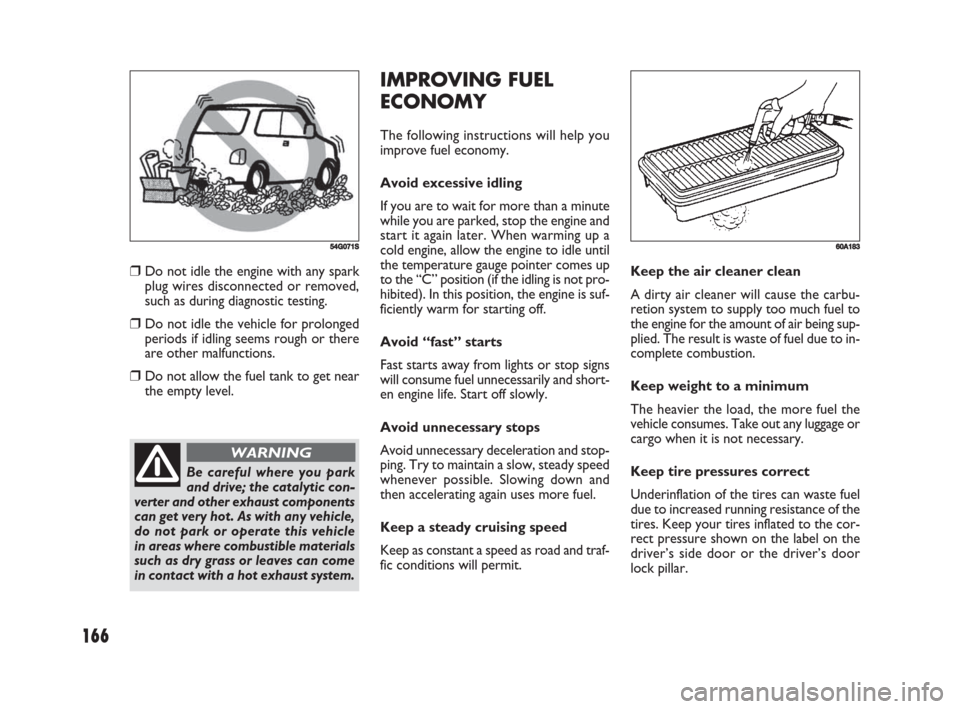
166
IMPROVING FUEL
ECONOMY
The following instructions will help you
improve fuel economy.
Avoid excessive idling
If you are to wait for more than a minute
while you are parked, stop the engine and
start it again later. When warming up a
cold engine, allow the engine to idle until
the temperature gauge pointer comes up
to the “C” position (if the idling is not pro-
hibited). In this position, the engine is suf-
ficiently warm for starting off.
Avoid “fast” starts
Fast starts away from lights or stop signs
will consume fuel unnecessarily and short-
en engine life. Start off slowly.
Avoid unnecessary stops
Avoid unnecessary deceleration and stop-
ping. Try to maintain a slow, steady speed
whenever possible. Slowing down and
then accelerating again uses more fuel.
Keep a steady cruising speed
Keep as constant a speed as road and traf-
fic conditions will permit.Keep the air cleaner clean
A dirty air cleaner will cause the carbu-
retion system to supply too much fuel to
the engine for the amount of air being sup-
plied. The result is waste of fuel due to in-
complete combustion.
Keep weight to a minimum
The heavier the load, the more fuel the
vehicle consumes. Take out any luggage or
cargo when it is not necessary.
Keep tire pressures correct
Underinflation of the tires can waste fuel
due to increased running resistance of the
tires. Keep your tires inflated to the cor-
rect pressure shown on the label on the
driver’s side door or the driver’s door
lock pillar.
60A183
❒Do not idle the engine with any spark
plug wires disconnected or removed,
such as during diagnostic testing.
❒Do not idle the vehicle for prolonged
periods if idling seems rough or there
are other malfunctions.
❒Do not allow the fuel tank to get near
the empty level.
54G071S
Be careful where you park
and drive; the catalytic con-
verter and other exhaust components
can get very hot. As with any vehicle,
do not park or operate this vehicle
in areas where combustible materials
such as dry grass or leaves can come
in contact with a hot exhaust system.
WARNING
149-166 Fiat16 New GB 3-09-2008 8:15 Pagina 166
Page 173 of 266
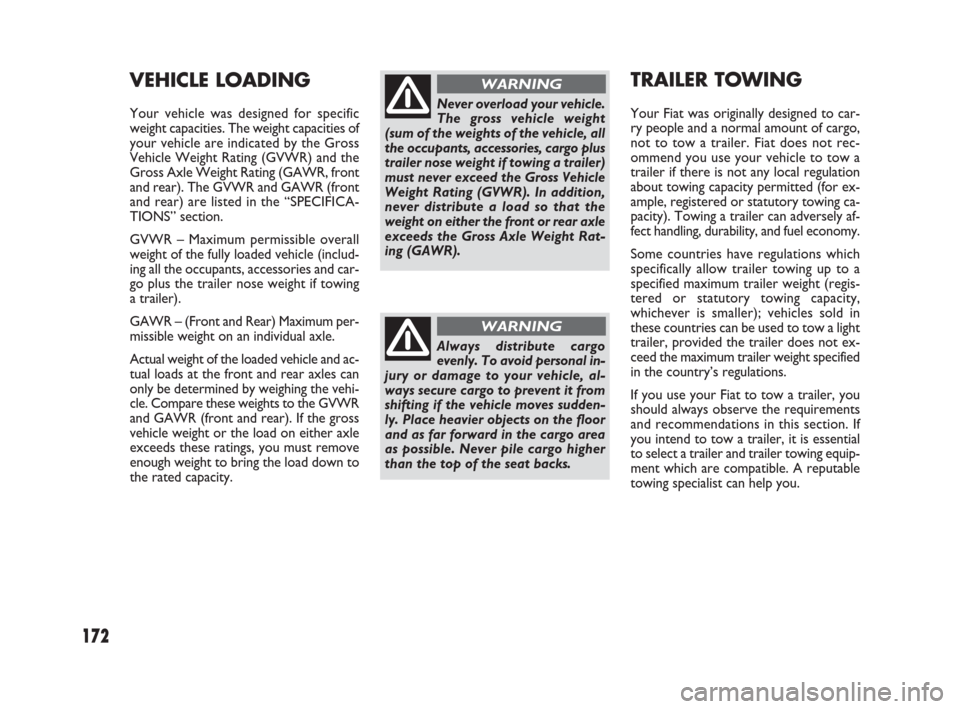
172
TRAILER TOWING
Your Fiat was originally designed to car-
ry people and a normal amount of cargo,
not to tow a trailer. Fiat does not rec-
ommend you use your vehicle to tow a
trailer if there is not any local regulation
about towing capacity permitted (for ex-
ample, registered or statutory towing ca-
pacity). Towing a trailer can adversely af-
fect handling, durability, and fuel economy.
Some countries have regulations which
specifically allow trailer towing up to a
specified maximum trailer weight (regis-
tered or statutory towing capacity,
whichever is smaller); vehicles sold in
these countries can be used to tow a light
trailer, provided the trailer does not ex-
ceed the maximum trailer weight specified
in the country’s regulations.
If you use your Fiat to tow a trailer, you
should always observe the requirements
and recommendations in this section. If
you intend to tow a trailer, it is essential
to select a trailer and trailer towing equip-
ment which are compatible. A reputable
towing specialist can help you.
VEHICLE LOADING
Your vehicle was designed for specific
weight capacities. The weight capacities of
your vehicle are indicated by the Gross
Vehicle Weight Rating (GVWR) and the
Gross Axle Weight Rating (GAWR, front
and rear). The GVWR and GAWR (front
and rear) are listed in the “SPECIFICA-
TIONS” section.
GVWR – Maximum permissible overall
weight of the fully loaded vehicle (includ-
ing all the occupants, accessories and car-
go plus the trailer nose weight if towing
a trailer).
GAWR – (Front and Rear) Maximum per-
missible weight on an individual axle.
Actual weight of the loaded vehicle and ac-
tual loads at the front and rear axles can
only be determined by weighing the vehi-
cle. Compare these weights to the GVWR
and GAWR (front and rear). If the gross
vehicle weight or the load on either axle
exceeds these ratings, you must remove
enough weight to bring the load down to
the rated capacity.Never overload your vehicle.
The gross vehicle weight
(sum of the weights of the vehicle, all
the occupants, accessories, cargo plus
trailer nose weight if towing a trailer)
must never exceed the Gross Vehicle
Weight Rating (GVWR). In addition,
never distribute a load so that the
weight on either the front or rear axle
exceeds the Gross Axle Weight Rat-
ing (GAWR).
WARNING
Always distribute cargo
evenly. To avoid personal in-
jury or damage to your vehicle, al-
ways secure cargo to prevent it from
shifting if the vehicle moves sudden-
ly. Place heavier objects on the floor
and as far forward in the cargo area
as possible. Never pile cargo higher
than the top of the seat backs.
WARNING
171-180 Fiat16 New GB 3-09-2008 8:41 Pagina 172
Page 174 of 266
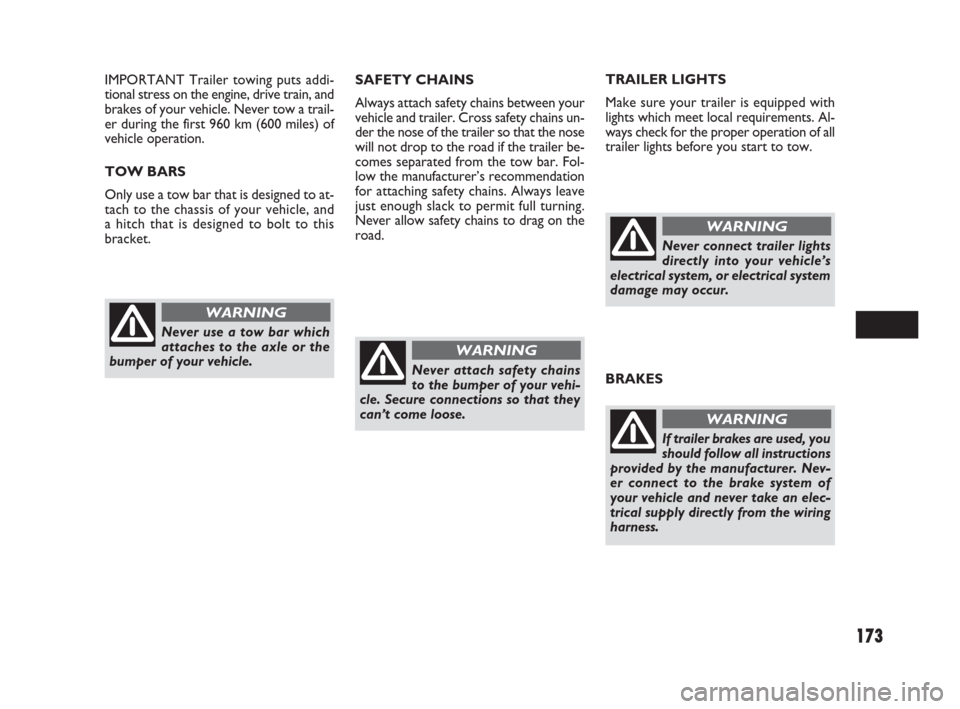
Never use a tow bar which
attaches to the axle or the
bumper of your vehicle.
WARNING
Never attach safety chains
to the bumper of your vehi-
cle. Secure connections so that they
can’t come loose.
WARNING
Never connect trailer lights
directly into your vehicle’s
electrical system, or electrical system
damage may occur.
WARNING
BRAKES
If trailer brakes are used, you
should follow all instructions
provided by the manufacturer. Nev-
er connect to the brake system of
your vehicle and never take an elec-
trical supply directly from the wiring
harness.
WARNING
173
SAFETY CHAINS
Always attach safety chains between your
vehicle and trailer. Cross safety chains un-
der the nose of the trailer so that the nose
will not drop to the road if the trailer be-
comes separated from the tow bar. Fol-
low the manufacturer’s recommendation
for attaching safety chains. Always leave
just enough slack to permit full turning.
Never allow safety chains to drag on the
road.TRAILER LIGHTS
Make sure your trailer is equipped with
lights which meet local requirements. Al-
ways check for the proper operation of all
trailer lights before you start to tow. IMPORTANT Trailer towing puts addi-
tional stress on the engine, drive train, and
brakes of your vehicle. Never tow a trail-
er during the first 960 km (600 miles) of
vehicle operation.
TOW BARS
Only use a tow bar that is designed to at-
tach to the chassis of your vehicle, and
a hitch that is designed to bolt to this
bracket.
171-180 Fiat16 New GB 3-09-2008 8:42 Pagina 173
Page 176 of 266
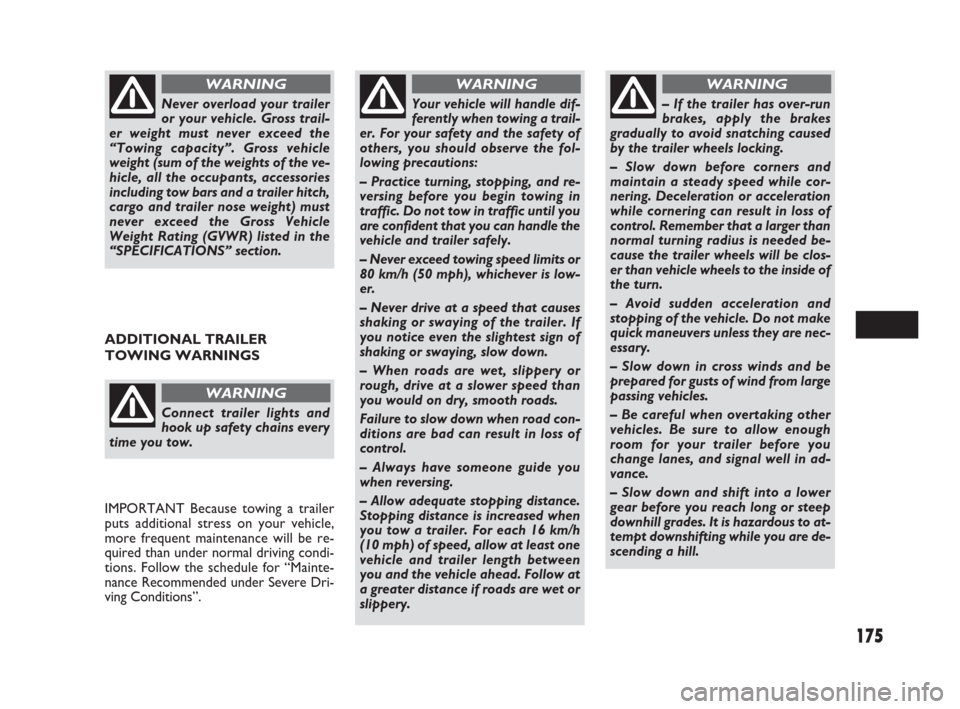
175
ADDITIONAL TRAILER
TOWING WARNINGS
Never overload your trailer
or your vehicle. Gross trail-
er weight must never exceed the
“Towing capacity”. Gross vehicle
weight (sum of the weights of the ve-
hicle, all the occupants, accessories
including tow bars and a trailer hitch,
cargo and trailer nose weight) must
never exceed the Gross Vehicle
Weight Rating (GVWR) listed in the
“SPECIFICATIONS” section.
WARNING
Connect trailer lights and
hook up safety chains every
time you tow.
WARNING
IMPORTANT Because towing a trailer
puts additional stress on your vehicle,
more frequent maintenance will be re-
quired than under normal driving condi-
tions. Follow the schedule for “Mainte-
nance Recommended under Severe Dri-
ving Conditions”.
Your vehicle will handle dif-
ferently when towing a trail-
er. For your safety and the safety of
others, you should observe the fol-
lowing precautions:
– Practice turning, stopping, and re-
versing before you begin towing in
traffic. Do not tow in traffic until you
are confident that you can handle the
vehicle and trailer safely.
– Never exceed towing speed limits or
80 km/h (50 mph), whichever is low-
er.
– Never drive at a speed that causes
shaking or swaying of the trailer. If
you notice even the slightest sign of
shaking or swaying, slow down.
– When roads are wet, slippery or
rough, drive at a slower speed than
you would on dry, smooth roads.
Failure to slow down when road con-
ditions are bad can result in loss of
control.
– Always have someone guide you
when reversing.
– Allow adequate stopping distance.
Stopping distance is increased when
you tow a trailer. For each 16 km/h
(10 mph) of speed, allow at least one
vehicle and trailer length between
you and the vehicle ahead. Follow at
a greater distance if roads are wet or
slippery.
WARNING
– If the trailer has over-run
brakes, apply the brakes
gradually to avoid snatching caused
by the trailer wheels locking.
– Slow down before corners and
maintain a steady speed while cor-
nering. Deceleration or acceleration
while cornering can result in loss of
control. Remember that a larger than
normal turning radius is needed be-
cause the trailer wheels will be clos-
er than vehicle wheels to the inside of
the turn.
– Avoid sudden acceleration and
stopping of the vehicle. Do not make
quick maneuvers unless they are nec-
essary.
– Slow down in cross winds and be
prepared for gusts of wind from large
passing vehicles.
– Be careful when overtaking other
vehicles. Be sure to allow enough
room for your trailer before you
change lanes, and signal well in ad-
vance.
– Slow down and shift into a lower
gear before you reach long or steep
downhill grades. It is hazardous to at-
tempt downshifting while you are de-
scending a hill.
WARNING
171-180 Fiat16 New GB 3-09-2008 8:42 Pagina 175
Page 178 of 266
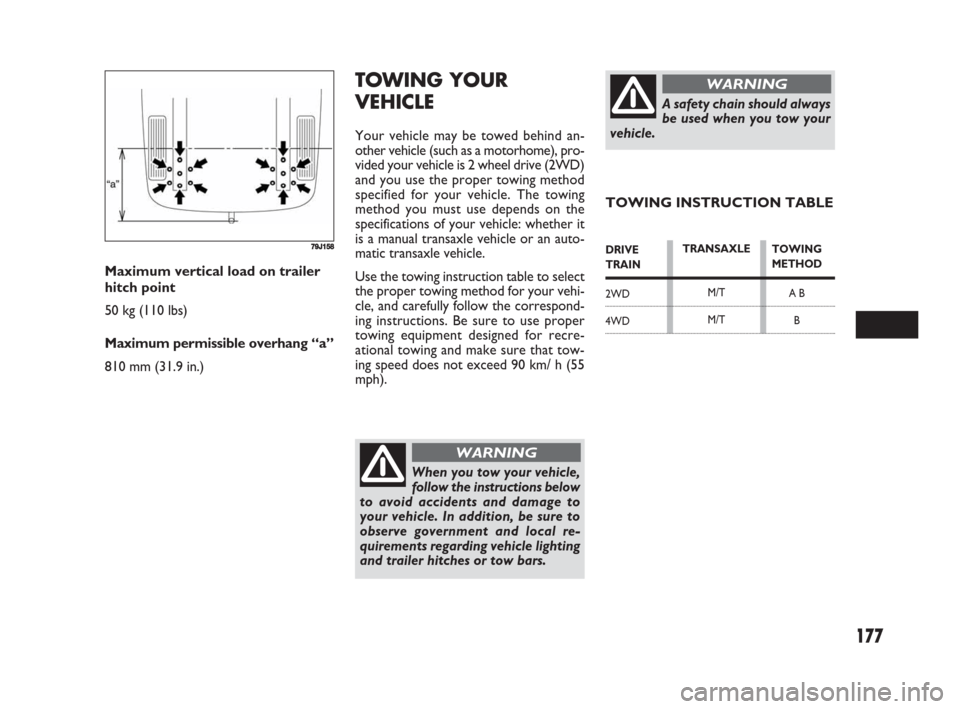
177
TOWING YOUR
VEHICLE
Your vehicle may be towed behind an-
other vehicle (such as a motorhome), pro-
vided your vehicle is 2 wheel drive (2WD)
and you use the proper towing method
specified for your vehicle. The towing
method you must use depends on the
specifications of your vehicle: whether it
is a manual transaxle vehicle or an auto-
matic transaxle vehicle.
Use the towing instruction table to select
the proper towing method for your vehi-
cle, and carefully follow the correspond-
ing instructions. Be sure to use proper
towing equipment designed for recre-
ational towing and make sure that tow-
ing speed does not exceed 90 km/ h (55
mph). Maximum vertical load on trailer
hitch point
50 kg (110 lbs)
Maximum permissible overhang “a”
810 mm (31.9 in.)
When you tow your vehicle,
follow the instructions below
to avoid accidents and damage to
your vehicle. In addition, be sure to
observe government and local re-
quirements regarding vehicle lighting
and trailer hitches or tow bars.
WARNING
A safety chain should always
be used when you tow your
vehicle.
WARNING
TOWING INSTRUCTION TABLE
DRIVE TRAIN
2WD
4WDTOWING
METHOD
A B
B TRANSAXLE
M/T
M/T
79J158
171-180 Fiat16 New GB 3-09-2008 8:42 Pagina 177
Page 185 of 266
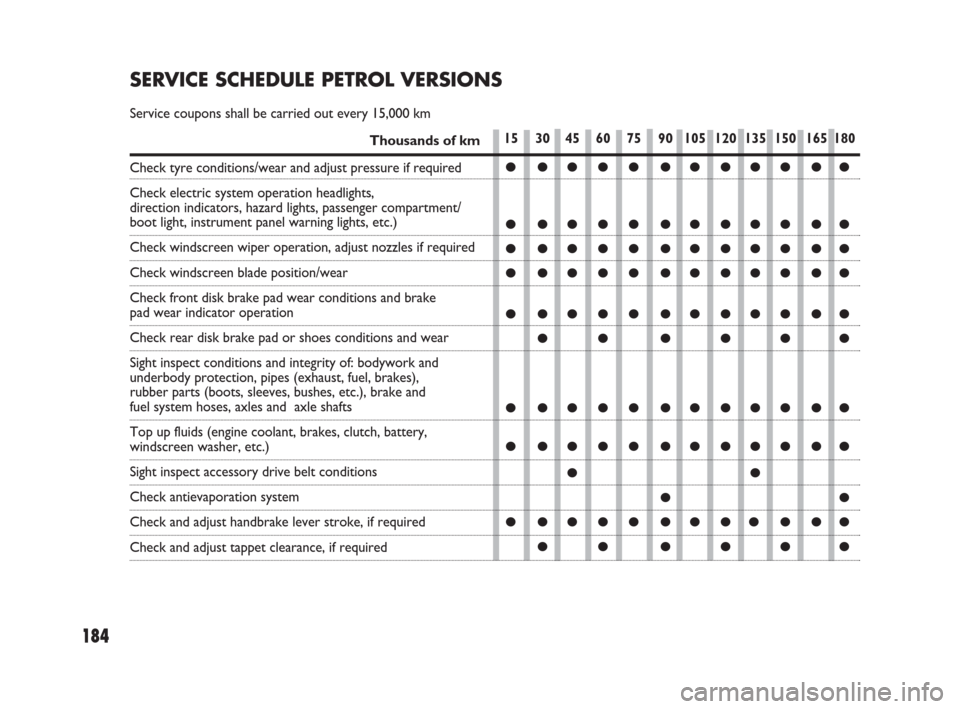
184
15 30 45 60 75 90 105 120 135 150 165 180
●●●●●●●●●●●●
●●●●●●●●●●●●
●●●●●●●●●●●●
●●●●●●●●●●●●
●●●●●●●●●●●●
●● ●●●●
●●●●●●●●●●●●
●●●●●●●●●●●●
●●
●●
●●●●●●●●●●●●
●● ●●●●
SERVICE SCHEDULE PETROL VERSIONS
Service coupons shall be carried out every 15,000 km
Thousands of km
Check tyre conditions/wear and adjust pressure if required
Check electric system operation headlights,
direction indicators, hazard lights, passenger compartment/
boot light, instrument panel warning lights, etc.)
Check windscreen wiper operation, adjust nozzles if required
Check windscreen blade position/wear
Check front disk brake pad wear conditions and brake
pad wear indicator operation
Check rear disk brake pad or shoes conditions and wear
Sight inspect conditions and integrity of: bodywork and
underbody protection, pipes (exhaust, fuel, brakes),
rubber parts (boots, sleeves, bushes, etc.), brake and
fuel system hoses, axles and axle shafts
Top up fluids (engine coolant, brakes, clutch, battery,
windscreen washer, etc.)
Sight inspect accessory drive belt conditions
Check antievaporation system
Check and adjust handbrake lever stroke, if required
Check and adjust tappet clearance, if required
181-224 Fiat16 New GB 3-09-2008 8:17 Pagina 184